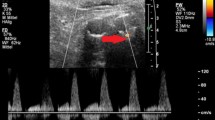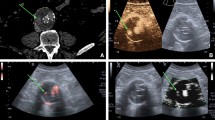Abstract
Objective
To evaluate the accuracy of contrast-enhanced ultrasound (CEUS) in comparison to CT angiography (CTA) to identify and classify endoleaks following abdominal aortic aneurism repair with endoprosthesis.
Materials and methods
A retrospective analysis of 181 patients treated with EVAR, from September 2009 to September 2014, was performed. Patients were evaluated with CEUS, CTA and angiography in the cases requiring treatment. Sac diameter, sac integrity, identification and classification of endoleaks were taken into consideration. Sensitivity, specificity, accuracy and negative predictive values were considered for each modality of endoleak identification.
Results
Forty-two endoleaks (23.2%; type II: 39 cases, type III: 3 cases) were documented. Sensitivity and specificity of CEUS and CT were, respectively, 97.6 and 90.5, 100 and 100%. In two cases, CEUS was able to better classify endoleaks compared to CT.
Conclusions
CEUS accuracy to identify endoleaks following EVAR is similar to CT. CEUS should be considered as an effective modality for the long-term surveillance of EVAR because of its capability to correctly classify endoleaks with no ionizing radiation exposure.
Riassunto
Obiettivi dello studio
Valutare l’accuratezza dell’eco-contrastografia (CEUS), confrontandola con angiografia con tomografia computerizzata (CT) per l’identificazione degli endoleak dopo trattamento di aneurisma dell’aorta addominale con endoprotesi.
Materiali
Da Settembre 2008 a Dicembre 2014, 181 pazienti consecutivi trattati con EVAR sono stati valutati con CEUS, CTA, ed anche con angiografia nei casi da ritrattare. Sono stati valutati: diametro della sacca, valutazione dell’integrita della sacca, identificazione e classificazione degli endoleaks. Sensibilità, specificità, accuratezza e valore predittivo negativo sono stati valutati per ogni modalita nell’identificazione degli endoleak.
Risultati
Quarantadue endoleak (23.2%; tipo II: 39 casi, tipo III: 3 casi) sono stati documentati. La Sensibilita della CEUS e della TC e stata rispettivamente del 97.6, 90.5%, mentre la specificita per entrambe e stata del 100%. In due casi la CEUS e stata in grado di classificare meglio gli endoleak rispetto alla CT. La sacca aneurismatica presentava alla CEUS e CDUS un diametro massimo compreso tra 39-82 mm, mentre alla TC tra 38 e 78 mm, senza significativa differenza tra le due metodiche.
Conclusioni
L’accuratezza della CEUS nell’identificazione degli endoleak e nella misurazione della sacca dopo EVAR, e simile alla TC con maggiore sensibilita ma analoga specificita. La CEUS e da considerarsi una modalita efficace per la sorveglianza a lungo termine degli EVAR in quanto capace di classificare correttamente gli endoleak senza esposizione a radiazioni ionizzanti.


Similar content being viewed by others
References
United Kingdom EVAR Trial Investigators, Greenhalgh RM, Brown LC, Powell JT et al (2010) Endovascular versus open repair of abdominal aortic aneurysm. N Engl J Med 362(20):1863–1871
Biancari F, Catania A, D’Andrea V (2011) Elective endovascular vs. open repair for abdominal aortic aneurysm in patients aged 80 years and older: systematic review and meta-analysis. Eur J Vasc Endovasc Surg 42(5):571–576
Cao P, De Rango P, Verzini F, Parlani G (2010) Endoleak after endovascular aortic repair: classification, diagnosis and management following endovascular thoracic and abdominal aortic repair. J Cardiovasc Surg 51(1):53–69
Mehta M, Sternbach Y, Taggert JB (2010) Long-term outcomes of secondary procedures after endovascular aneurysm repair. J Vasc Surg 52(6):1442–1449
Corriere MA, Feurer ID, Becker SY (2004) Endoleak following endovascular abdominal aortic aneurysm repair: implications for duration of screening. Ann Surg 239(6):800–805
Raman KG, Missig-Carroll N, Richardson T, Muluk SC, Makaroun MS (2003) Color-flow duplex ultrasound scan versus computed tomographic scan in the surveillance of endovascular aneurysm repair. J Vasc Surg 38(4):645–651
Manning BJ, O’Neill SM, Haider SN (2009) Duplex ultrasound in aneurysm surveillance following endovascular aneurysm repair: a comparison with computed tomography aortography. J Vasc Surg 49(1):60–65
Carrafiello G, Laganà D, Recaldini C (2006) Comparison of contrast-enhanced ultrasound and computed tomography in classifying endoleaks after endovascular treatment of abdominal aorta aneurysms: preliminary experience. Cardiovasc Intervent Radiol 29(6):969–974
Dill-Macky MJ, Wilson SR, Sternbach Y, Kachura J, Lindsay T (2007) Detecting endoleaks in aortic endografts using contrast-enhanced sonography. AJR Am J Roentgenol 188(3):W262–W268
van der Laan MJ, Bartels LW, Viergever MA et al (2006) Computed tomography versus magnetic resonance imaging of endoleaks after EVAR. Eur J Vasc Endovasc Surg 32(4):361–365
Wieners G, Meyer F, Halloul Z et al (2010) Detection of type II endoleak after endovascular aortic repair: comparison between magnetic resonance angiography and blood-pool contrast agent and dual-phase computed tomography angiography. Cardiovasc Intervent Radiol 33(6):1135–1142
Parodi JC, Palmaz JC, Barone HD (1991) Transfemoral intraluminal graft implantation for abdominal aortic aneurysms. Ann Vasc Surg 5(6):491–499
Blum U, Voshage G, Lammer J et al (1997) Endoluminal stent-grafts for infrarenal abdominal aortic aneurysms. N Engl J Med 336(1):13–20
Harris PL, Vallabhaneni SR, Desgranges P, Becquemin JP, van Marrewijk C, Laheij RJ (2000) Incidence and risk factors of late rupture, conversion, and death after endovascular repair of infrarenal aortic aneurysms: the EUROSTAR experience. European Collaborators on Stent/graft techniques for aortic aneurysm repair. J Vasc Surg 32(4):739–749
White GH, Yu W, May J, Chaufour X, Stephen MS (1997) Endoleak as a complication of endoluminal grafting of abdominal aortic aneurysms: classification, incidence, diagnosis, and management. J Endovasc Surg 4(2):152–168
Bernhard VM, Mitchell RS, Matsumura JS (2002) Ruptured abdominal aortic aneurysm after endovascular repair. J Vasc Surg 35(6):1155–1162
Toya N, Fujita T, Kanaoka Y, Ohki T (2008) Endotension following endovascular aneurysm repair. Vasc Med 13(4):305–311
Rand T, Uberoi R, Cil B, Munneke G, Tsetis D (2012) Quality improvement guidelines for imaging detection and treatment of endoleaks following endovascular aneurysm repair (EVAR). Cardiovasc Intervent Radiol 36(1):35–45. doi:10.1007/s00270-012-0439-4 (epub 2012 Jul 26)
Stavropoulos SW, Charagundla SR (2007) Imaging techniques for detection and management of endoleaks after endovascular aortic aneurysm repair. Radiology 243(3):641–655
Cantisani V, Ricci P, Grazhdani H et al (2011) Prospective comparative analysis of colour-Doppler ultrasound, contrast-enhanced ultrasound, computed tomography and magnetic resonance in detecting endoleak after endovascular abdominal aortic aneurysm repair. Eur J Vasc Endovasc Surg 41(2):186–192
Bakken AM, Illig KA (2010) Long-term follow-up after endovascular aneurysm repair: is ultrasound alone enough? Perspect Vasc Surg Endovasc Ther 22(3):145–151
Uthoff H, Peña C, Katzen BT et al (2012) Current clinical practice in postoperative endovascular aneurysm repair imaging surveillance. J Vasc Interv Radiol 23(9):1152e6–1159e6
Napoli V, Bargellini I, Sardella SG et al (2004) Abdominal aortic aneurysm: contrast-enhanced US for missed endoleaks after endoluminal repair. Radiology 233(1):217–225
Cantisani V, Bertolotto M, Weskott HP et al (2015) Growing indications for CEUS: The kidney, testis, lymph nodes, thyroid, prostate, and small bowel. Eur J Radiol 84(9):1675–1684. doi:10.1016/j.ejrad.2015.05.008 (epub 2015 May 14)
Cantisani V, Grazhdani H, Clevert DA et al (2015) EVAR: Benefits of CEUS for monitoring stent-graft status. Eur J Radiol 84(9):1658–1665. doi:10.1016/j.ejrad.2015.07.001 (epub 2015 Jul 10)
D’Onofrio M, Vecchiato F, Cantisani V et al (2008) Intrahepatic peripheral cholangiocarcinoma (IPCC): comparison between perfusion ultrasound and CT imaging. Radiol Med 113(1):76–86. doi:10.1007/s11547-008-0225-1 (epub 2008 Feb 25)
Cantisani V, Ricci P, Erturk M, Pagliara E et al (2010) Detection of hepatic metastases from colorectal cancer: prospective evaluation of gray scale US versus SonoVue® low mechanical index real time-enhanced US as compared with multidetector-CT or Gd-BOPTA-MRI. Ultraschall Med 31(5):500–505. doi:10.1055/s-0028-1109751
Iezzi R, Basilico R, Giancristofaro D, Pascali D, Cotroneo AR, Storto ML (2009) Contrast-enhanced ultrasound versus color duplex ultrasound imaging in the follow-up of patients after endovascular abdominal aortic aneurysm repair. J Vasc Surg 49(3):552–560
Gilabert R, Buñesch L, Real MI et al (2012) Evaluation of abdominal aortic aneurysm after endovascular repair: prospective validation of contrast-enhanced US with a second-generation US contrast agent. Radiology 264(1):269–277. doi:10.1148/radiol.12111528 (epub 2012 May 15)
Bokor D, Chambers JB, Rees PJ, Mant TG, Luzzani F, Spinazzi A (2001) Clinical safety of SonoVue, a new contrast agent for ultrasound imaging, in healthy volunteers and in patients with chronic obstructive pulmonary disease. Invest Radiol 36(2):104–109
Torzilli G (2005) Adverse effects associated with SonoVue use. Expert Opin Drug Saf 4(3):399–401
Piscaglia F, Bolondi L, Italian Society for Ultrasound in Medicine and Biology (SIUMB) Study Group on Ultrasound Contrast Agents (2006) The safety of Sonovue in abdominal applications: retrospective analysis of 23188 investigations. Ultrasound Med Biol 32(9):1369–1375
Chung J, Kordzadeh A, Prionidis I et al (2015) Contrast-enhanced ultrasound (CEUS) versus computed tomography angiography (CTA) in detection of endoleaks in post-EVAR patients. Are delayed type II endoleaks being missed? A systematic review and meta-analysis. J Ultrasound 18(2):91–99. doi:10.1007/s40477-014-0154-x
Author information
Authors and Affiliations
Corresponding author
Ethics declarations
Funding
This study was not funded.
Conflict of interest
Vito Cantisani lectured for Bracco, Samsung, Toshiba and Fabrizio Calliada lectured for Hitachi and Mindray but they did not receive funding. The other authors declare that they have no conflict of interest.
Ethical approval
All procedures performed in studies involving human participants were in accordance with the ethical standards of the institutional and/or national research committee and with the 1964 Helsinki declaration and its later amendments or comparable ethical standards.
Informed consent
Informed consent was obtained from all individual participants included in the study.
Rights and permissions
About this article
Cite this article
David, E., Cantisani, V., Grazhdani, H. et al. What is the role of contrast-enhanced ultrasound in the evaluation of the endoleak of aortic endoprostheses? A comparison between CEUS and CT on a widespread scale. J Ultrasound 19, 281–287 (2016). https://doi.org/10.1007/s40477-016-0222-5
Received:
Accepted:
Published:
Issue Date:
DOI: https://doi.org/10.1007/s40477-016-0222-5




